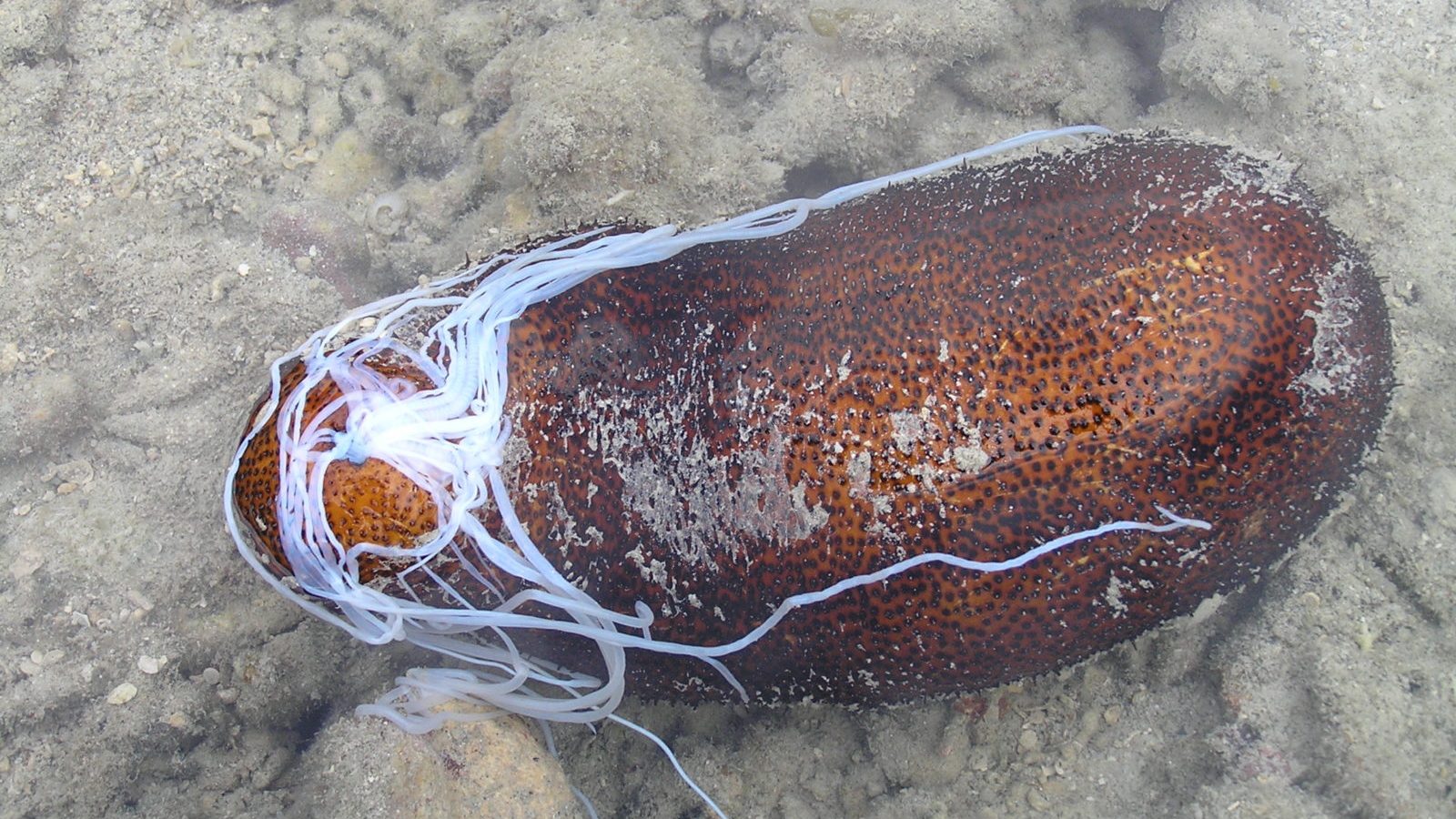Globular denizens of the ocean floor, sea cucumbers are not much to look at. But for some reason I find them endearingly uncharismatic.
They have no faces, or even eyes, just a digestive tract with a hole at either end housed in a body that resembles a well-formed turd. (And is also unavoidably phallic.) And their entire life revolves around sucking up the seafloor and pooping it right back out again.
You honestly couldn’t design a less-interesting animal if you tried. And yet still I love them, because they manage to be absolutely fascinating despite their utter lack of charisma.
Why, exactly, are they so interesting? Well…
-
They Projectile-Poop Their Own Organs Onto Predators

Photo © Pierre Pouliquin / Flickr It’s hard to imagine that anything — including humans — would actually want to eat a sea cucumber. And yet they have several predators, from fish to sea turtles to people. Unfortunately, sea cucumbers come up a bit short when it comes to self defense. Some species, like the sandfish, spend the day buried in the sand as a lame attempt at camouflage.
Others take a different route and projectile-poop their own internal organs all over any would-be predators — or curious science writers — that prod them a little too vigorously. They then simply re-grow whatever organs have gone missing.
-
They Breathe Through Their Butt

Sea apple sea cucumber, Pseudocolochirus violaceus. Photo © budak / Flickr No, really. I am not kidding. All species of sea cucumber breathe by dilating their anal sphincter to suck water into their rectum, where specialized structures called respiratory trees — butt lungs — extract oxygen molecules from the water.
If that fact alone doesn’t make you love sea cucumbers then you’ve officially lost your childlike sense of wonder.
-
They Let Fish Live Inside Their Anus

A pinhead pearlfish, Encheliophis boraborensis. Photo © orangkucing / Wikimedia Commons And here you thought you were done reading about sea cucumber butts.
Several species of parasitic pearlfish actually live inside sea cucumber bums. After smelling their way to an ideal host, the pearlfish swims head-first into the void. As the sea cucumber pumps water in and out to breathe, the fish slowly but surely wiggle their way inside. (Other pearlfish take the opposite approach, reversing in tail-first.)
Some pearlfish species are harmless, simply bumming a free room from the sea cucumbers. (Pun intended). Presumably it’s not ideal to have a fish up your butt, but it could be worse. Oh so much worse… as other pearlfish species eat the sea cucumber’s gonads from the inside.
-
They Absolutely Infuriate Scientists

A feather-mouthed sea cucumber, Synapta maculata. Photo © Bernard Dopont / Wikimedia Commons You’d think that a shuffling little mobile colon would be fairly easy for scientists to study, right? Guess again.
Scientists have found it nearly impossible to track sea cucumber movements. If you stick a tag or tracking device in them they just extrude it out from their skin. Dye or scaring to mark individuals? Both disappear. As one scientist put it: “They just don’t want to be studied… which is funny because it should be as easy as studying trees.”
Even trying to work out something as simple as growth rates is a challenge, because it all depends on their environment. Take two individuals of the same species and age, put them in different places, and they could grow at different rates.
And then sometimes they shrink. If a sea cucumber is starving, instead of rolling over dead it just eats itself, gradually becoming smaller and smaller.
-
They’re Unsung Heroes of the Seagrass

Psychropotes. Photo © NOAA Photo Library / Wikimedia Commons A sea cucumber’s daily life is about as boring as its vegetable namesakes, but it’s also important to ocean ecosystems. As they scoot around the seafloor, eating and pooping, sea cucumbers help distribute nutrients and remove excess organic matter from the sediment and water. Research shows that the presence of sea cucumbers leads to more productive seagrass beds.
And by dissolving calcium carbonate and pooing it back out into the water, they help provide the raw materials that corals need to grow their exoskeletons. Higher levels of calcium carbonate also increase the alkalinity of the water, which acts as a buffer against localized acidification.
They might not be a keystone species, but for a little blob of mobile intestines, sea cucumbers do a pretty good job of making themselves useful. -
They’re at Risk of Extinction

Photo © Jerry Kirkhart / Wikimedia Commons I don’t think you’ll argue with me when I say that sea cucumbers have the culinary appeal of a boiled kitchen sponge. And yet populations around the globe are collapsing because sea cucumbers are considered a delicacy in some Asian cultures.
Hauled out of the water, sea cucumbers are gutted, packed with salt, boiled, dried, boiled again, dried again, and then shipped off to markets in Hong Kong and Singapore. There they sell for exorbitant prices to consumers, who — wait for it — boil them again and serve them as a high-status meal for special occasions.
The Nature Conservancy is working with Papua New Guinea communities to set up sustainable management of their sea cucumber fisheries, in the hopes of protecting these creatures and securing stable income for rural communities.




I absolutely loved reading this!!
I love learning about, well, pretty much anything and everything!!
You made this so fun!!
Hahahhaha!! Go you!!
❤️